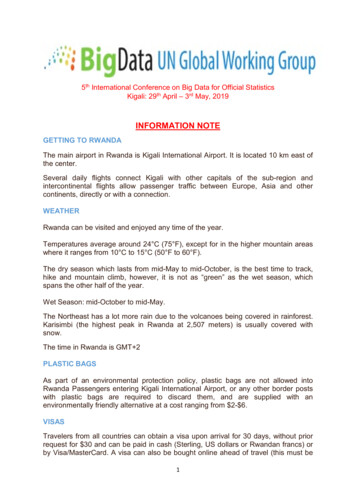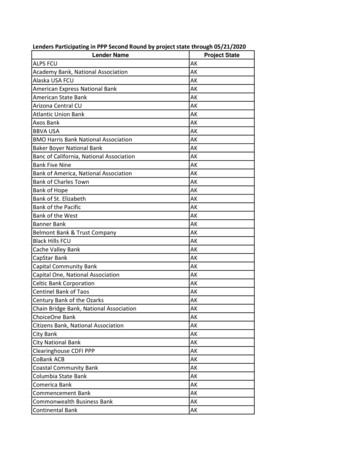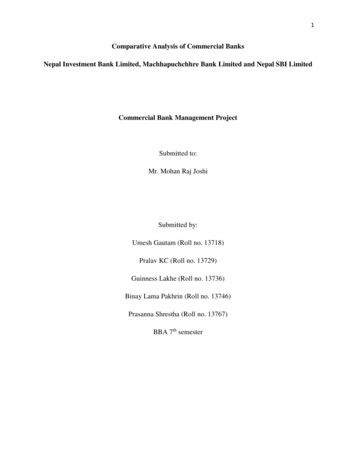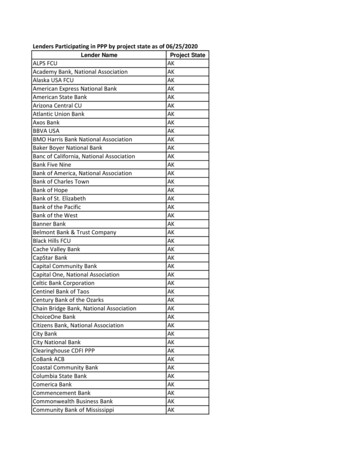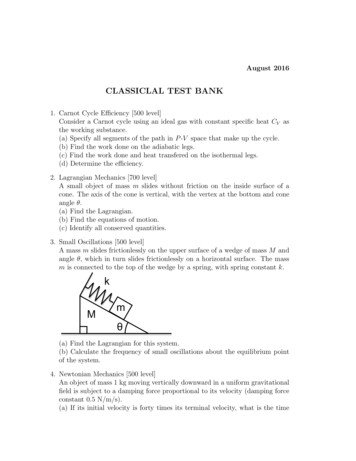
Transcription
August 2016CLASSICLAL TEST BANK1. Carnot Cycle Efficiency [500 level]Consider a Carnot cycle using an ideal gas with constant specific heat CV asthe working substance.(a) Specify all segments of the path in P -V space that make up the cycle.(b) Find the work done on the adiabatic legs.(c) Find the work done and heat transfered on the isothermal legs.(d) Determine the efficiency.2. Lagrangian Mechanics [700 level]A small object of mass m slides without friction on the inside surface of acone. The axis of the cone is vertical, with the vertex at the bottom and coneangle θ.(a) Find the Lagrangian.(b) Find the equations of motion.(c) Identify all conserved quantities.3. Small Oscillations [500 level]A mass m slides frictionlessly on the upper surface of a wedge of mass M andangle θ, which in turn slides frictionlessly on a horizontal surface. The massm is connected to the top of the wedge by a spring, with spring constant k.kMmθ(a) Find the Lagrangian for this system.(b) Calculate the frequency of small oscillations about the equilibrium pointof the system.4. Newtonian Mechanics [500 level]An object of mass 1 kg moving vertically downward in a uniform gravitationalfield is subject to a damping force proportional to its velocity (damping forceconstant 0.5 N/m/s).(a) If its initial velocity is forty times its terminal velocity, what is the time
required to reach 1.1 times terminal velocity?(b) What is the energy dissipated during the slowdown to 1.1 times terminalvelocity?5. Binding Energy [500 level](a) How much energy would you have to supply to break up the Earth completely, i.e. convert it into an infinitely dispersed dust? You can ignore: (i)any and all technical hurdles involved in this process (that’s for the engineersto worry about); (ii) chemistry and radiation losses; (iii) any nonuniformity inthe Earth’s composition.(b) If you reassembled it rapidly (so that no energy radiated, and ignoringchemistry, etc) would it melt?Some numbers:MC “6 ˆ 1024 kgRC “6 ˆ 106 mCC “ 1 ˆ 103 J{kg KTCmelt “1 ˆ 104 KG“ 6 ˆ 10 11 N m2 {kg26. Small Oscillations [500 level]A pipe of radius r rolls without slipping inside another of radius R.(a)Find the frequency of small oscillations in which the axes remain parallel.(b) Discuss the limits as (i) r Ñ 0 and (ii) r Ñ R.7. Newtonian Mechanics [500 level]A satellite attached to the surface of the Earth by a long flexible cable withlinear mass density µ, revolves with constant angular velocity ω, equal to therotation frequency of the Earth.(a) Show that the cable must be straight and radial.(b) Derive and solve the differential equation for the tension in the cable asa function of r, the satellite’s distance from the center of the Earth. Assumethe cable is long compared to the Earth’s radius.(c) Demonstrate that the tension is maximum atˆr“2gRCω2 1{3where g is the acceleration due to gravity at the Earth’s surface.8. Newtonian Mechanics [500 level](a) If all linear dimensions of the solar system were doubled, and if the massesof everything in the system were also doubled at the same time, how wouldthe orbital period of the Moon compare to its current value?(b) By what factor would the total energy change?
9. Hamiltonian Mechanics [700 level]The motion of an electron in an electromagnetic field is consistent with theLagrangiane 1L “ mv 2 A v eφ.2c(a) Derive the Hamiltonian.(b) Show from the Hamiltonian equations of motion that the electron is subjectto the Lorentz force.(c) Solve the equations of motion for the case in which the field is a uniformmagnetic field perpendicular to the initial velocity.10. Small Oscillations [500 level]A mass m is suspended, pendulum-like, from another mass M via string oflength L. M is attached to a spring of spring constant k and constrained tomove only horizontally.MkLm(a) Find the Lagrangian for this system, assuming no friction.(b) Find the frequency of small oscillation.11. Statistical Mechanics of a Rubber Band [700 level]Model a rubber band as a massless chain of N links, each with two possiblelengths, L and 2L. An amount of work W is required to stretch a link from Lto 2L.(a) Find the entropy of the chain as a function of its length.(b) If a mass M is suspended from the chain, what is the chain length as afunction of temperature T ?(c) What happens in the limits of zero and infinite temperature?(d) Are there any values of M , W , and L for which the chain contracts forrising temperature?
12. Lagrangian Dynamics [700 level]LmmL(a) For the double pendulum shown, find the kinetic energy in terms of theangular variables and their derivatives.(b) Deduce the potential energy.(c) What is the Lagrangian? Find the equations of motion in the angularvariables.(d) Given small oscillations, equal pendula arm lengths, and equal masses,solve the equations of motion.13. Newtonian Mechanics [500 level]A rocket initially at rest is fired vertically upward in a uniform gravitationalfield. The rocket ejects mass, from an initial propellant mass Mp at a muzzlevelocity vp at a rate of α.(a) Calculate the minimum α required for the rocket to lift off the ground.(b) For this α, calculate the maximum speed of the rocket.14. Thermodynamics [500 level]A house is to be maintained at a temperature lower than the external temperature Tout . For convenience, consider a cubical house of side length L. Itis cooled by a continuously running air conditioning unit, which is a perfectCarnot engine with constant input power P . The wall thickness is W andtheir thermal conductivity is k.(a) Calculate the inside temperature.(b) What happens when the insulation is poor or the power is low?15. Action [700 level](a) Write down a formula for the period T of a particle executing one-dimensionalperiodic motion in a potential.
(b) Show that this period T is the derivative of the action¿I “ dx ppxqwith respect to the energy E.(c) Calculate the period of a particle of mass m and energy E in a potentialU “ α x .16. Ideal Gas [500 level]A spherical soap bubble with surface tension (energy per unit surface area) Σis filled with N molecules of an ideal gas. Neglect radiative heat loss.(a) What is the equilibrium radius of the bubble as a function of temperature?(b) If the bubble has an initial small radius, R « 0, how much energy must besupplied in the form of heat to double its radius?17. Small Oscillations [500 level]A bead of mass m slides without friction on a circular loop of radius R. Theloop lies in a vertical plane and rotates about its vertical diameter with constant angular speed ω. Let θ be the angular position of the bead along theloop.ωmR(a) Show that there is a stable equilibrium at θ “ 0 if ω ă ωc for some criticalangular speed ωc , and find ωc .
(b) Show that if ω ą ωc , there is a stable equilibrium for some θ ą 0 and findthat θ as a function of ω.(c) Find the frequency of small oscillations about θ ‰ 0.18. Newtonian Mechanics [500 level]On the back of a truck is a cylinder, with radius R and mass M , free to roll.The coefficient of static friction between the cylinder and the truck bed is µ1 .The truck accelerates, causing the cylinder to roll without slipping off the backof the truck. The acceleration is such that, if it were any greater, the cylinderwould slip, rather than roll. The cylinder rolls a distance equal to twice itscircumference before falling off.(a) What is the cylinder’s angular speed as it leaves the truck?(b) The coefficient of dynamic friction between the cylinder and road surfaceis µ2 . How far does the cylinder travel on the ground, x, before slippingceases?(c) How much work is done on the cylinder by the road? Calculate both thechange in kinetic energy of the sphere, Wα and the work done by friction,Wβ “ F x, and discuss which is right.19. Lagrangian Dynamics [500 level]A particle moves in the xy-plane under the influence of a potential U px, yq “Kxy, where K is a constant.(a) Find the equation of motion(b) Find the solution if the particle is initially at rest at px0 , 0q.20. Non-Ideal Gas [500 level]Consider a van der Waals gas, which satisfies the equation of state a P 2 pv bq “ kT,vwhere v “ V {N .(a) State the first law of thermodynamics and show that CV , the specific heatat constant volume isˇBU ˇˇCV “BT ˇV(b) State the second law of thermodynamics and show thatˇˇBU ˇˇBP ˇˇ“ λa T λb PBV ˇTBT ˇVwhere λa and λb are constants. Determine λa and λb .(c) Using part (b), find the general form of U pV, T q. Using part (a), rewriteU pV, T q in terms of CV . What simplification results if CV is constant?
21. Newtonian [500 level]Two particles, m1 and m2 , attract each other with a central force Fprq “ kr,where r is the separation between the particles. Let V pr “ 0q “ 0, with Ebeing the energy and L the angular momentum.(a) Given L, what is the allowed range for E?(b) Given E and L, what are the minimal and maximal distances the particlemay be from one-another?22. Hamiltonian Mechanics [700 level]Consider a system described by the general coordinates qi and pi . If there issome fixed, singular r such that qr and pr are confined to finite ranges, thenthe virial theorem holdsF BFBBHBHpr “ qr.BprBqrYou will prove that this is so.BHBH(a) Establish a simple relation between dtd ppr qr q and Bppr qr Bq.rr(b) Consider the average of the relation from (a) over long times, and therebyprove the virial theorem. Recall thatż1 Txf y “ limdt f ptq.T Ñ8 T 0(c) Use the virial theorem to show that for a three-dimensional harmonicoscillator, xT y “ xV y, where T and V are the kinetic and potential energies,respectively.23. Newtonian Mechanics [500 level]A homogeneous cube of length L is balanced on one edge on a horizontal plane.If the cube is given a slight nudge so that it falls, show that the angular speedof the plane when the face strikes the plane isg ?ω 2 “ α p 2 1q,Land find α for the cases of:(a) no slipping(b) slipping without friction.24. Normal Modes [500 level]Consider the system of masses and springs shown in the figure, with Hookiansprings, one-dimensional motion, and no friction.
kmk2mk(a) Find the equations of motion in terms of x1 and x2 and find the normalmode frequencies.(b) Without further calculation:(i) Give an argument showing that the general motion of the system is a linearcombination of the normal modes.(ii) Describe qualitatively the motions of the two masses in each of the normalmodes.(iii) Describe initial conditions that result in only one normal mode beingexcited, so that the motion can be described by a single frequency.25. Newtonian Mechanics [500 level]A uniform, thin square plate ABCD on a frictionless horizontal surface isrotating around its vertical diagonal AC with angular speed ω, as shown inthe figure.ωADBC(a) If the vertex B is suddenly stopped, in which direction and with whatangular speed does the square rotate around B?(b) Discuss the conservation (or non-conservation) of mechanical energy in theprocess given in (a).26. Hamiltonian Mechanics [500 level]A particle of mass m is moving in a potential V “ V pr, θ, φq.
(a) Derive the Hamiltonian of the system in spherical coordinates.(b) Write down Hamilton’s equations of motion.27. Statistical Mechanics [700 level]A given system has N distinguishable sites. At each site is a spin that can bein either the up or down state. The spin down state has energy zero, and thespin up state has energy E0 .(a) What is the partition function for a subsystem with only single site?(b) What is the partition function for the entire system of N sites?(c) Derive expressions for the energy E, the free energy F , and the entropy Sof the system for the two cases E0 {kT " 1 and E0 {kT ! 1.(d) In the high-temperature case S “ N k ln 2. Is this result consistent withS “ k ln Ω, where Ω is the number of accessible states?28. Newtonian Mechanics [500 level]Two identical balls of mass m, connected by a spring of constant k, are attached to the ceiling by a string, as shown in the figure. The string is cut attime t “ 0.mkm(a) Find the acceleration of each ball at t “ 0.(b) Describe the subsequent motion of the balls.29. Lagrangian Mechanics [500 level]A small uniform cylindrical mass m, of radius a, sits atop a large fixed cylinderof radius R. The small cylinder is given a small push and rolls without slipping.(a) Set up the Lagrangian for the system.(b) When does the small cylinder fall off the large one?30. Orbital Mechanics [700 level]
(a) Consider an attractive central force Fprq “ pk{rn qr̂. Given k and n, findthe condition that guarantees the existence of a stable circular orbit.(b) Find a similar condition for a general attractive central force Fprq.(c) Investigate the stability of circular orbits in a force field described by thescreened Coulomb potentialkV prq “ e r{a ,rwith positive constants k and a.31. Hamiltonian Mechanics [700 level](a) For a one-dimensional harmonic oscillator, find Hamilton’s canonical equations and show that they agree with Newton’s equations of motion.(b) Explain the behavior of their solutions in phase space.32. Statistical Mechanics [700 level]Consider an ideal gas with N molecules, molecular mass m, volume V , andtemperature T .(a) What are the partition function, the free energy, and the chemical potential for this system?(b) Let the gas be in contact with a large absorption surface with NA absorption sites, each of which can absorb at most one molecule. The absorptionenergy per molecule is EA . Assuming N " NA , what is the grand partitionfunction for the absorption sites?(c) What fraction of the sites are occupied?33. Statistical Mechanics [500 level]Consider a model of the Earth’s atmosphere as an ideal gas in equilibrium, atconstant temperature in a uniform gravitational field.(a) Derive an expression relating pressure and mass density of the gas. Identifyany constants that you may need, but do not do any numerical calculations.(b) Derive an expression for the mass density as a function of height above thesurface.(c) Estimate the height above the surface at which the atmosphere is 100 timesthinner than at the surface.34. Lagrangian Mechanics [500 level]A smooth horizontal plane has a small frictionless hole. A string going throughthe whole connects two masses, ms and mh , on the surface, and hangingfrom the string, respectively. The hanging mass is constrained to move onlyvertically, while the mass on the surface is constrained to move in the plane.The string is always stretched straight.
msmh(a) Find the Lagrangian for this system.(b) Derive Lagrange’s equations of motions.(c) There are two constants of motion in this system. Identify them.35. Hamiltonian Mechanics [700 level]Two masses, m1 and m2 , move under their mutual gravitational attraction in auniform external gravitational field whose acceleration is g. Take as generalizedcoordinates X, Y , and Z for the center of mass (with Z in the direction of g),the distance r between m1 and m2 , and the angles θ and φ which specify thedirection of the line from m1 to m2 .(a) Write the kinetic energy in terms of the generalized coordinates.(b) Give expressions for the six generalized momenta.(c) Give the Hamiltonian for the system.(d) Find Hamilton’s equations of motion.(w) Identify ignorable (i.e. cyclic) coordinates. Argue that the problem canbe reduced to two separate one-degree-of-freedom problems.(f) Derive expressions for the six generalized forces, QX , QY , . . . , Qφ .36. Lagrangian Mechanics [700 level]As shown in the figure, three massless springs, with spring constant k, areconnected in a circle with a mass m between each. The system is constrainedto move along the circle’s circumference.
mkkmmk(a) Find the Lagrangian of the system.(b) What are the equations of motion for the three displacements, s1 , s2 , ands3 ?(c) Find the normal modes and frequencies, and discuss the characteristics ofthe normal modes.37. Moment of Inertia [500 level]Given a right angle isosceles triangle of uniform thickness and density:(a) Find the elements of the moment of inertia tensor with respect to a set ofcoordinate axes which you may choose at your convenience.(b) What are the principal axes through the center of mass?38. Hamiltonian Mechanics [700 level]A massless rod of length 2L has identical masses m at each end. The rodis free to rotate about its center, which is attached to a vertical axle. Theplane containing the rod and axle is constrained to rotate about the axle withconstant angular speed ω.
mLLmθω(a) Find the Lagrangian and Hamiltonian of this two-particle system in termsof one suitable generalized coordinate.(b) Is H a constant of the motion?(c) Is the energy of the system conserved?39. Thermodynamics [500 level](a) Show that during the adiabatic expansion of an ideal gas, the temperatureand pressure changes are related byγ 1 dPdT“Tγ Pwhere the adiabatic index γ “ CP {CV is the ratio of the specific heats.(b) Assume that air undergoes an ideal gas adiabatic expansion as altitudeincreases. Derive an expression for the variation of temperature with altitudein terms of the average molecular weight of air and other constants.40. Newtonian Mechanics [500 level]A rope of total mass M and length L is suspended vertically with its lowerend touching a weighing scale. The rope is released and falls onto the scale.(a) Find x, the length of rope that has landed on the scale by a time t.(b) What is the reading of the scale as a function of x?41. Lagrangian Mechanics [500 level]Consider the pulley system in the figure. The pulley near the ceiling is fixedand massless. The lower pulley is movable with radius R and mass M .
MmR(a) Obtain the Lagrangian of the system in terms of a suitable generalizedcoordinate.(b) Find the equation of motion for this system.(c) For what values of the parameters does the system have an equilibrium?42. Lagrangian Mechanics [700 level]Consider a particle moving in a potential V px, y, zq.(a) Prove that translational invariance of the Lagrangian in a particular direction implies linear momentum conservation in that direction.(b) Prove that rotational invariance implies angular momentum conservation.43. Lagrangian Mechanics [500 level]The Lagrangian for a spherical pendulum with mass M and string length is19 2 1 M p sin θφq9 2 M g cos θ.L “ M p θq22(a) Determine the Lagrangian equations of motion.(b) Determine the momenta canonically conjugate to θ and φ in terms of thecoordinates and their time derivatives.(c) Construct the Hamiltonian.(d) Determine Hamilton’s equations of motion.44. Thermodynamics [500 level]A gas of photons at temperature T in a vessel of volume V has energy E “aV T 4 and pressure P “ E{3V .(a) Write down the Maxwell relation for the temperature as a derivative of theenergy.
(b) Use the result of part (a) and the expression for E to find a differentialequation for the entropy S. Solve this equation, noting the undeterminedconstant.(c) Infer the value of the constant from the third law of thermodynamics.45. Newtonian Mechanics [500 level]A particle moving in one dimension is under the influence of a force F “ kx kx3 {a2 , where k and a are constants and k is positive.(a) Determine the energy U pxq. Assume U p0q “ 0.(b) At what other values of x does U pxq “ 0?(c) Consider the motion of the particle in the interval 5 a ă x ă 5 a . Fortotal energy E ă 0, describe the possibilities for the trajectory of the particle.Where does the particle go? In what direction does it move? Make a roughplot of U pxq and show the trajectory or trajectories on the plot.(d) Describe the possibilities for the trajectory for E ą ka2 {4.(e) Describe the possibilities for the trajectory for 0 ă E ă ka2 {4.46. Statistical Mechanics [500 level]A particle of mass m sits on a hot plate with temperature T . The air abovethe plate is in equilibrium with the plate surface.(a) Find the average height, y0 ” xyy, of the particle above the plate due tothermal agitation.a(b) Find the root mean square fluctuation of the average height, xpy y0 q2 y.47. Newtonian Mechanics [500 level]The bumper on a billiard table is designed so that when a ball of radiusa, rolling without slipping, strikes the bumper at normal incidence, the ballbounces off without any loss of energy.
(a) What is the torque imparted to the ball during such a collision, if the heightof the bumper is h?(b) Determine h, for an elastic collision with no slipping.48. Newtonian Mechanics [500 level]Consider the two-dimensional force due to the four identical, ideal springswith force constant k, each under a small displacement from the equilibriumposition. Each spring has one end in common with the other springs and oneend that slides frictionlessly on one of four guide rods arranged in a square asshown.
(a) Show that the force on a particle attached to the common point isF “ 2kxî 2ky ĵ.(b) Is this force conservative? Why?(c) Show that the potential function isU px, yq “ kpx2 y 2 q constant(d) Express F and U in terms of polar coordinates ρ and φ.49. Thermodynamics [500 level]A monoatomic ideal gas of N atoms is initially contained in a vessel of volumeV and held at temperature T .(a) The gas is allowed to expand freely to double its volume. What are thetemperature, pressure, and internal energy after the expansion?(b) Then the gas is compressed adiabatically by a piston, back to its initialvolume V . What are the temperature, pressure, and internal energy after thecompression?(c) During which of these two processes is entropy generated?50. Statistical Mechanics [700 level]Consider an ideal gas, with known number of particles N , pressure P , temperature T , and molecular mass m, contained within a vessel.(a) Write down the volumetric particle density as a function of particle velocity.(b) How many impacts per second per unit area are there on the chamberwalls?51. Newtonian Mechanics [500 level]A cylindrical block of wood of mass density ρw , radius R, and height h ispartially immersed in a liquid of mass density ρ and then released, as shownin the figure.(a) What is the equilibrium height (relative to the top surface of the block)above the water level zeq ?
(b) If the block was initially slightly raised, so that z0 ” zpt “ 0q ą zeq , andthen released, calculate zptq assuming no viscosity.(c) Now assume that the liquid is viscous, and that the viscous force is proportional to the velocity, as given by Fv “ b v. How is the motion of theblock modified? Write down the equation of motion.(d) What is the condition on the viscous parameter b for the motion to becritically damped?52. Lagrangian [700 level]A particle of mass m moves in an attractive central potential V prq “ α1 rkα ,where k and α are constants. Assume that the angular momentum L of theparticle is not zero.(a) Write down the Lagrangian. Show that the angular momentum L of theparticle is conserved.(b) Determine the total energy of the system in terms of m, r, r,9 k, α, and L.What is the radial kinetic energy term, which is only a function of the radialvelocity of the particle? What is the effective potential energy term Veff prq,which is a function of the radial position of the particle?(c) Sketch the effective potential Veff above as a function of r for the threecases α ă 0, 0 ă α ă 2, and 2 ă α. For what values of α does a stable circularorbit exist? For what values of α are all orbits bounded?(d) For those values of α which support a stable circular orbit, calculate theradius, r0 , of the stable circular orbit in terms of m, r, k, α.53. Normal Modes [700 level]Consider an infinitely long, linear harmonic chain with particles of two different masses, m and M , and force constant κ, as shown below. Let a be theequilibrium distance between two neighboring particles of the same mass, andlet qj and rj be the deviations from their equilibrium positions for the j-thparticle of mass m, and the j-th particle of mass M , respectively.(a) Find the kinetic and potential energies for the system and write down theLagrangian for the system. Determine the equations of motion forqj and rj .(b) Apply the usual strategy of assuming solutions of the form qj “ Qj exppiωtqand rj “ Rj exppiωtq. What are the equations for the amplitudes Qj and Rj
that result from the equationsof motion?řř 8(c) Now, let Qpkq “ 8Qj“ 8 j exppijkaq and Rpkq “j“ 8 Rj exppijkaq,where the sum on j is over all particles of mass m for Qpkq or over all particlesof mass M for Rpkq.Using the above definitions for Qpkq and Rpkq, which are identified as thenormal modes of the system, perform the sum over all of the amplitudes inpart b above and obtain the equations for Qpkq and Rpkq.(d) Find the normal mode frequencies (i.e. the dispersion relation) ωpkq forthe system. Note that π{2a ď k ěă π{2a.54. Thermodynamics [700 level]Blackbody radiation can be treated as a macroscopic thermodynamic system.Its energy density is given byU“4VσT 4cwhere σ is the Stefan-Boltzmann constant.(a) Determine the form of the fundamental relation whose independent variables are V and T , and obtain expressions for the pressure and specific heat.(Note that the entropy S for the system vanishes at T “ 0.)(b) Starting from the entropy and internal energy of an ideal gas,« ˆ# 3{2 ff V 4πm U5 lnS “ N kB2N 3h2 NU “3N kB T,2(1)compute its free energy and the grand canonical potential.55. Small Oscillations [700 level]A thin circular loop of radius R, with mass m distributed uniformly alongits circumference, is free to roll along a horizontal surface without slipping. Apoint particle of mass m is attached to the inside of the loop and is constrainedto slide along the inside perimeter of the loop without friction. The system isin a uniform gravitational acceleration g.
(a) Write down the Lagrangian for this system.(b) Find the equations of motion and any possible equilibrium positions forthe particle.(c) Which of the equilibrium positions are stable and which are unstable?(You may qualitatively answer this part, if you wish.) (d) Find the frequencyof small amplitude oscillations of the particle about all possible positions ofstable equilibrium. Consider your results in the limit M " m and discusswhether they are reasonable.56. Relativistic Kinematics [500 level]A ball of putty of mass m travels at speed v towards another ball of putty,also of mass m, which is at rest (but which is free to move) in the lab frame.They collide and stick together forming a new object.(a) Assume that the collision is head on and the speed v of the incoming ballis nonrelativistic, i.e. much smaller than c, the speed of light. Determine thefinal speed V and mass M of the new nonrelativistic object after the collision.(b) Again assume that the collision is head on, but now assume that the speedv of the incoming ball is relativistic, so that it can not be neglected comparedwith c. Determine the final speed V and rest mass M of the new relativisticobject after the collision.(c) Compare the nonrelativistic and relativistic cases with respect to the conservation of total kinetic energy and total mass during the collision. For allcases where there is not conservation, explicitly show non-conservation andqualitatively explain why the value is larger or smaller after the collision.57. Central Force Motion [700 level]A particle of mass m moves under the influence of the central potential V prq “ kr 4 .(a) Show that the motion occurs in a plane. Hence, use polar coordinates towrite the Lagrangian for the system. Determine all constants of the motion.(b) Make a plot of the effective potential for the radial motion of the particle. Give the general condition for a circular orbit. Does the above potential
support circular orbits? If so, determine them in terms of constants of themotion. Are they stable?(c) At time t “ 0 the particle is at r “ r0 and is moving with a velocity v “ v0directed at an angle of 45 with respect to the radial outward direction.Write down the condition for the particle to escape to infinity. From theseinitial conditions, calculate the minimum value v0 for which the particle isguaranteed to escape to infinity. You may work in, and leave your answer in,units for which k “ m “ 1.58. Thermodynamics [500 level]The initial state of monoatomic ideal gas is described by TA , PA , and VA . Thegas is taken over the path AÑBÑC quasistatically as shown in the sketch.The volumes are related: VB “ 23 VA and VC “ 2VA .(a) How much work does the gas do on the path AÑB and what is the changein its internal energy?(b) How much heat is absorbed in going from AÑB?(c) Derive the expression for the entropy change for an arbitrary process BÑC.(d) If BÑC is an adiabatic process, find the final gas pressure and the entropychange (from the general expression obtained in part c).
59. Thermodynamics [500 level]A system of two energy levels E0 and E1 is populated by N particles at temperature T . Assume that E1 ą E0 .(a) Derive an expression for the average energy per particle as function oftemperature.(b) Determine the limiting behavior and value for average energy per particlein the limits of zero and infinite temperature.(c) Derive an expression for specific heat of the system.(d) Compute specific heat in the limits of zero and infinite temperature.60. Small Oscillations [700 level]A homogeneous disk of radius R and mass M rolls without slipping on aninclined surface that makes an angle θ with respect to the vertical. The diskis constrained to be in contact with the inclined plane at all times. The diskis attracted to a point A located at a vertical distance d above the surface.Assume that the force of attraction is proportional to the distance from thedisk’s center of mass to the point A; i.e. assume that F “ kr, where r is thedistance from the point A to the disk’s center of mass.(a) Determine the equilibrium position of the disk, with respect to the positionon the surface directly under point A.(b) Find the frequency of oscillations around the position of equilibrium.61. Newtonian
On the back of a truck is a cylinder, with radius Rand mass M, free to roll. The coe cient of static friction between the cylinder and the truck bed is 1. The truck accelerates, causing the cylinder to roll without slipping o the back of the truck. The acceleration is such that, if it were any greater, the cylinder would slip, rather than roll.






